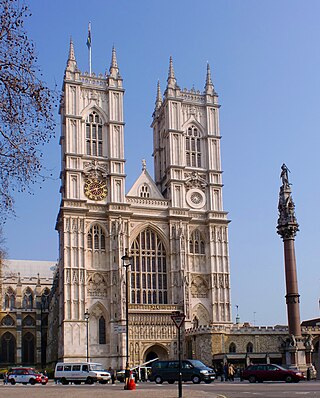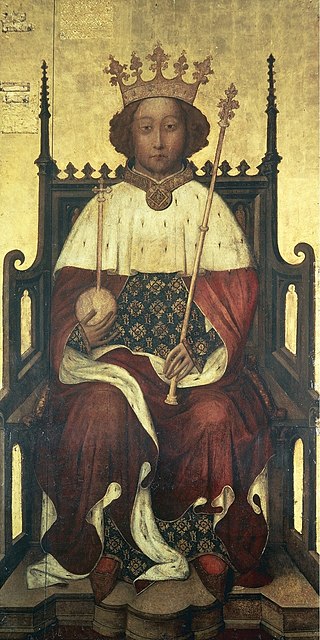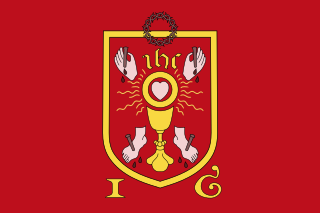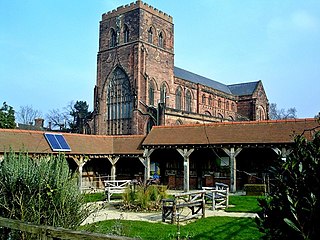
Edward the Confessor was an Anglo-Saxon English king and saint. Usually considered the last king of the House of Wessex, he ruled from 1042 until his death in 1066.

Westminster Abbey, formally titled the Collegiate Church of Saint Peter at Westminster, is an Anglican church in the City of Westminster, London, England. Since 1066, it has been the location of the coronations of 40 English and British monarchs and a burial site for 18 English, Scottish, and British monarchs. At least 16 royal weddings have taken place at the abbey since 1100.

Edward I, also known as Edward Longshanks and the Hammer of the Scots, was King of England from 1272 to 1307. Concurrently, he was Lord of Ireland, and from 1254 to 1306 he ruled Gascony as Duke of Aquitaine in his capacity as a vassal of the French king. Before his accession to the throne, he was commonly referred to as the Lord Edward. The eldest son of Henry III, Edward was involved from an early age in the political intrigues of his father's reign. In 1259, he briefly sided with a baronial reform movement, supporting the Provisions of Oxford. After reconciliation with his father, he remained loyal throughout the subsequent armed conflict, known as the Second Barons' War. After the Battle of Lewes, Edward was held hostage by the rebellious barons, but escaped after a few months and defeated the baronial leader Simon de Montfort at the Battle of Evesham in 1265. Within two years, the rebellion was extinguished and, with England pacified, Edward left to join the Ninth Crusade to the Holy Land in 1270. He was on his way home in 1272 when he was informed of his father's death. Making a slow return, he reached England in 1274 and was crowned at Westminster Abbey.

Richard II, also known as Richard of Bordeaux, was King of England from 1377 until he was deposed in 1399. He was the son of Edward, Prince of Wales, and Joan, Countess of Kent. Richard's father died in 1376, leaving Richard as heir apparent to his grandfather, King Edward III; upon the latter's death, the 10-year-old Richard succeeded to the throne.

The Parliament of England was the legislature of the Kingdom of England from the 13th century until 1707 when it was replaced by the Parliament of Great Britain. Parliament evolved from the great council of bishops and peers that advised the English monarch. Great councils were first called Parliaments during the reign of Henry III. By this time, the king required Parliament's consent to levy taxation.

The Church of St Margaret, Westminster Abbey is in the grounds of Westminster Abbey on Parliament Square, London, England. It is dedicated to Margaret of Antioch, and forms part of a single World Heritage Site with the Palace of Westminster and Westminster Abbey.

The Pilgrimage of Grace was a popular revolt beginning in Yorkshire in October 1536, before spreading to other parts of Northern England including Cumberland, Northumberland, Durham and north Lancashire, under the leadership of Robert Aske. The "most serious of all Tudor period rebellions", it was a protest against Henry VIII's break with the Catholic Church, the dissolution of the lesser monasteries, and the policies of the King's chief minister, Thomas Cromwell, as well as other specific political, social, and economic grievances.

This article covers the history of London from the Norman conquest of England in 1066 to the death of Richard III in 1485. During this period, London became the capital of England, as monarchs held Parliament at the Palace of Westminster, beginning in 1265 and increasing over the 14th century. London appointed its first recorded Lord Mayor in this period, Henry FitzAilwin, in 1189. In the 12th century, the writer William Fitzstephen described it as florilegium urbanum — "flower of cities".
Events from the 1290s in England.
Carucage was a medieval English land tax enacted by King Richard I in 1194, based on the size—variously calculated—of the taxpayer's estate. It was a replacement for the danegeld, last imposed in 1162, which had become difficult to collect because of an increasing number of exemptions. Carucage was levied just six times: by Richard in 1194 and 1198; by John, his brother and successor, in 1200; and by John's son, Henry III, in 1217, 1220, and 1224, after which it was replaced by taxes on income and personal property.
Heist is a one-off 2008 television comedy-drama, written by Peter Harness and directed by Justin Hardy. It was completed at the end of 2006 and first broadcast on 23 April 2008 on BBC Four as part of its Medieval season. Loosely based on real events surrounding Richard of Pudlicott, it is a parody of and/or homage to heist films, set in medieval England, using several of that genre's conventions, and trailed under the same tagline as the 2003 remake of The Italian Job. As per the medieval setting, the film dialogue contains several Middle English and pseudo-Middle English expressions and insults. Marshall as lead character narrates several parts of the backstory to the audience during the film.
The Remonstrances of 1297 were a set of complaints presented by a group of nobles in 1297, against the government of King Edward I of England. Foremost among the nobles were Roger Bigod, Earl of Norfolk, Marshal of England, and Humphrey de Bohun, Earl of Hereford, Constable of England.

Taxation in medieval England was the system of raising money for royal and governmental expenses. During the Anglo-Saxon period, the main forms of taxation were land taxes, although custom duties and fees to mint coins were also imposed. The most important tax of the late Anglo-Saxon period was the geld, a land tax first regularly collected in 1012 to pay for mercenaries. After the Norman Conquest of England in 1066, the geld continued to be collected until 1162, but it was eventually replaced with taxes on personal property and income.

The medieval English saw their economy as comprising three groups – the clergy, who prayed; the knights, who fought; and the peasants, who worked the land and towns involved in international trade. Over the five centuries of the Middle Ages, the English economy would at first grow and then suffer an acute crisis, resulting in significant political and economic change. Despite economic dislocation in urban and extraction economies, including shifts in the holders of wealth and the location of these economies, the economic output of towns and mines developed and intensified over the period. By the end of the period, England had a weak government, by later standards, overseeing an economy dominated by rented farms controlled by gentry, and a thriving community of indigenous English merchants and corporations.
The economics of English towns and trade in the Middle Ages is the economic history of English towns and trade from the Norman invasion in 1066, to the death of Henry VII in 1509. Although England's economy was fundamentally agricultural throughout the period, even before the invasion the market economy was important to producers. Norman institutions, including serfdom, were superimposed on a mature network of well-established towns involved in international trade. Over the next five centuries the English economy would at first grow and then suffer an acute crisis, resulting in significant political and economic change. Despite economic dislocation in urban areas, including shifts in the holders of wealth and the location of these economies, the economic output of towns developed and intensified over the period. By the end of the period, England would have a weak early modern government overseeing an economy involving a thriving community of indigenous English merchants and corporations.
Sir John le Blund was Mayor of London, England for eight consecutive years.

Thomas Prestbury was an English medieval Benedictine abbot and university Chancellor.
Lenton, or de Lenton is a surname, and Anglo-Norman gentry family, originating in the midlands of England. The family are believed to have originated in Lenton in Nottinghamshire, the etymology of which is a "hamlet on the river Leen".
Maltolt or "bad tax" was the name given to the new taxes on wool in England of 1294–1297. Protests against the maltolt played their part in forcing the confirmation of the charters from the Crown.

The history of the monarchy of the United Kingdom and its evolution into a constitutional and ceremonial monarchy is a major theme in the historical development of the British constitution. The British monarchy traces its origins to the petty kingdoms of Anglo-Saxon England and early medieval Scotland, which consolidated into the kingdoms of England and Scotland by the 10th century. Anglo-Saxon England had an elective monarchy, but this was replaced by primogeniture after England was conquered by the Normans in 1066. The Norman and Plantagenet dynasties expanded their authority throughout the British Isles, creating the Lordship of Ireland in 1177 and conquering Wales in 1283. In 1215, King John agreed to limit his own powers over his subjects according to the terms of Magna Carta. To gain the consent of the political community, English kings began summoning Parliaments to approve taxation and to enact statutes. Gradually, Parliament's authority expanded at the expense of royal power.











